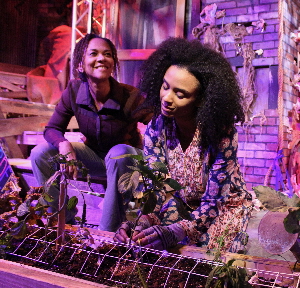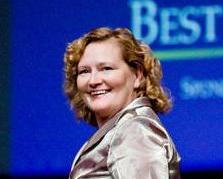
Antonio Amadeo, Laura Turnbull and Alex Alvarez in the world premiere of Michael McKeever’s Daniel’s Husband at Island City Stage / Photo by Robert Figueroa
This is a version of an article commissioned by and which originally appeared in the October edition of American Theatre magazine.
By Bill Hirschman
Indisputably, regional theaters such as those in South Florida have been a significant wellspring for new plays reaching back 30 years.
But a quickening sea change has occurred quietly but demonstrably over the past decade:
Regional theaters – once reliant on warhorses and the latest New York hit — have become the primary incubator and showcase for new work in America and the source of much of what will become the core of the lasting literature of American theater for the coming decades.
The five boroughs of New York City still premiere perhaps four dozen new works each year. But the array of regional companies from Seattle to Atlanta, Miami to Jupiter, who collectively host at least twice that many, are no longer the farm team but arguably the feeder system.
No one has definitely quantified the phenomenon, but the accumulation of anecdotal evidence is impossible to ignore.
“If we want to have a discussion as a number game, it’s not even close and hasn’t even been close for 25 years,” said playwright Steven Dietz. A few of his 32 plays and 11 adaptations have been seen off-Broadway, but his plays have been produced hundreds of times across the country and around the world including Theatre Lab, Actors’ Playhouse and Florida Stage.
Amy Rose Marsh, literary director for the Samuel French Inc. licensing company, acknowledged New York’s one-time primacy, but added, “There’s definite movement away from that, and we’ve seen a ton of (regional) theaters doing world premieres.”
The scope and depth is evident travelling to the most modest theater communities that usually have one company committed to new work, tracking submissions to play competitions, quizzing artistic directors and interviewing successful playwrights who rarely – and in some cases never – have a New York production.
Exhibit one: The corridor from Key West through Miami, Fort Lauderdale and Palm Beach County is home to more than 48 professional companies. At least 12 have commissioned, developed and/or presented new work including Zoetic Stage, which counts two playwrights as founding members; Island City Stage, which favors LGBT-centric works; and City Theatre, which premieres short plays. Palm Beach Dramaworks has been developing plays through its Dramaworkshop for three years and has two new plays on its upcoming schedule. Louis Tyrrell ran Florida Stage in Palm Beach County for 24 years, once touted as the largest regional theater producing exclusively new works. Then he moved to Arts Garage in Delray Beach, and now has a resident professional company Theatre Lab at Boca Raton campus of Florida Atlantic University, which has hosted Israel Horovitz, Deborah Zoe Laufer and Michael Hollinger. Even more local troupes give playwrights-at-work the crucial second and third productions. Others such as GableStage in Miami regularly host staged readings that they are not the first to produce fully. It also serves as a base for emerging local playwrights like Miamian Christopher Demos-Brown, a national prize-winning writer whose sixth play American Son bowed at Barrington Stage in Massachusetts last summer.
Exhibit two: Consider the breadth of the National New Play Network (NNPN) with 110-member theaters dedicated to producing brand new work, only two based in New York City. Its 31 core members pledge that a play selected for the Rolling World Premiere program will receive at least three full professional productions enabling the playwright to evolve the piece. The members range from renowned League of Resident Theatres companies to troupes in Tucson, Skokie and Indianapolis. In its most recently finished fiscal year NNPN approved 37 productions of 10 different plays at 33 member theaters.
Nationally, some companies mount only one a year. Some are dedicated entirely to new work, such as the Contemporary American Theatre Festival (CATF) in West Virginia, which attracts D.C. Metro patrons for a summer stay, or the Denver Center’s Colorado New Play Summit in February. None of this counts development-only labs like the Sundance Institute and the Eugene O’ Neill Theatre Center.

Steve Yockey
Steve Yockey is a rising Los Angeles playwright whose Blackberry Winter had seven productions just this season but who has never been mentioned in The New York Times. His work has been seen in City Theatre’s Summer Shorts. He wrote in an email, “So many of those mid-size regional theaters are channeling resources specifically into the cultivation of new work right now. Places like Kitchen Dog in Dallas, or The Theatre at Boston Court in Pasadena, or Actor’s Express in Atlanta. And if you aren’t following Forum Theatre in D.C. yet then you’re missing out on a pretty fearless model for development, production, and audience engagement around new work.”
Other venues are so venerable that they are taken for granted such as the Humana Festival of New American Plays at Actors Theatre of Louisville, which has produced more than 450 new plays since 1993 including Pulitzer Prize-winners Dinner with Friends, Crimes of the Heart, The Gin Game, and Pulitzer finalists Becky Shaw, Keely and Du, and Omnium-Gatherum, plus Getting Out, Agnes of God, Extremities and Danny and the Deep Blue Sea.
Exhibit three: Oregon Shakespeare Festival’s American Revolutions: The United States History Cycle. Begun in 2008, the program will have commissioned 37 new plays by the end of 2017 “sprung from moments of change in United States history” and meant to mirror “the scope and scale of Shakespeare’s history plays.” Already, the project has spent $3 million on writers, dramaturgs, workshop participants, administrators and others. Seven plays have been produced at the festival, such as Robert Schenkkan’s All The Way, with the rest expected in the coming years. Most of those seven plus three others have been exported to Arena Stage, Steppenwolf, Yale Rep and Berkeley Rep among many other stages.
Exhibit four: Examine the number and quality of submissions for the new play competition created by the American Theatre Critics Association (ATCA) in 1977 and funded by the Harold and Mimi Steinberg Charitable Trust since 2000. Noting the plentiful New York-centric playwriting awards, the Steinberg/ATCA prize specifically recognizes regional theaters as a significant source of new work.
Winners of the Steinberg/ATCA top prize or citation include eight of August Wilson’s works including Fences, three by Lee Blessing including A Walk in the Woods, three by Jane Martin including Keeley and Du, two by Sarah Ruhl, two by Arthur Miller, two by Donald Margulies including Dinner with Friends, All the Way, The Last Night of Ballyhoo, A Shayna Maidel, Getting Out and Intimate Apparel. Also honored have been works by Michael Weller, Jon Robin Baitz, Romulus Linney, Mac Wellman, Jeffrey Sweet, Lisa Loomer, Michael Cristofer, Peter Parnell, Charles Mee, Horton Foote, Craig Wright, Adam Rapp, Tracy Letts, Jeffrey Hatcher and Lanford Wilson. More recently, it honored Lauren Gunderson’s ubiquitous I and You, Johnna Adams’ Gideon’s Knot and Lucas Hnath’s The Christians.
Every last one (and they represent a small percentage of potential nominees) originated in regional theaters without which many or most simply would not exist.
Exhibit five: These plays form much of the backbone of what is seen in America’s theaters. Becky’s New Car is a title few New Yorkers have heard because it never played in the metropolitan area. But Steven Dietz’s droll affecting play about a runaway wife was birthed in Seattle in 2008 and has had 187 productions across the country including Actors’ Playhouse.

Karen Stephens and Shien Mompremier in the first full staging of Allison Gregory’s Motherland at Theatre Lab
“If you build it, they will come…”
The movement reflects a growing audience hungry for new work. Consider that CATF, like other festivals, is located in the middle of nowhere, yet people from nearly 40 states schedule three- and five-day jaunts to immerse themselves in new work. It attracted record-breaking attendance last year of 15,000, said Ed Herendeen, founder and producing director.
Certainly, some patrons resist new work. Tyrrell tells those people, “If you’re interested in Pulitzer Prize winners of the ’60s ’70s and ’80s or last year’s hit from Broadway, you can go” to a nearby theater. Sometimes when a theater feathers new work into its more traditional season, season subscribers balk.
But troupes like Mad Cat Theatre Company in Miami simply raised an aesthetic banner to attract an existing niche audience of adventurous often younger patrons.

Nan Barnett
Some companies tout their consistent quality to persuade audiences to take a chance on works they have never heard of. The key is educating their expectations for a work in progress. Nan Barnett, formerly of Florida Stage and now executive director of the National New Play Network, said, “You talk to your audience that they are part of the development of a work that will end up in the theater canon, that their responses will be part of shaping a piece that will be representative of our time.”
That appeal is so strong that companies fight each other for the rights to advertise a “world premiere” of an author’s latest work. In some cases, a troupe will provide the actual first full production, but find the playwright has promised the “world premiere” status to a more established company. Jim Steinberg, director of the Steinberg Trust and one of the nation’s leading supporters of new work, wryly refers to it as “an arms race.”
Still, receptive audiences and local donors often cannot produce enough revenue to support these efforts alone. Theaters often rely on grants from government-related groups like the National Endowment for the Arts, corporate sponsors like Humana and foundations like the Pew Charitable Trust. The American Revolutions project in Oregon is underwritten by more than 30 groups including the Andrew W. Mellon Foundation and the Edgerton Foundation New Play Awards.
“Who can explain it, who can tell you why.…”
The reasons for this change – and further validation of it – come down to art and commerce.
—While the market for warhorses remains, that audience is dying out. Artistic directors and their boards believe that the only way to attract and sustain current and future patrons is to deliver theater they haven’t seen and work they can’t find on YouTube or Netflix.

Michael McKeever
“The standard theatergoing audience has gotten sick of seeing the same things over and over again,” said veteran South Florida playwright Michael McKeever. Audiences “are interested in seeing new work that reflects their lifestyle, their pace, their vernacular.” His regionally successful Carbonell-winning Daniel’s Husband, about a gay couple dealing with tragic consequences of not marrying, played in New York last spring.
The artists, too, “want to have an impact in their community talking about today’s issues through the lens of an artist,” Barnett said. “It’s a priority: To keep making theater relevant and vital, we have to keep making (new) theater.”
—Obviously, helping birth new work is the ultimate joy for many artists. Tyrrell enthused, “As an artist, you have to want to put the original paint on the canvas.… How could you not want to see new work develop and flourishing if you are a theater artist?” Beneath that allure is the hope that the local theater is helping forge the next Death of a Salesman or American Buffalo since “yesterday’s classic at one point in their lives were brand new and perhaps scandalous,” he said.
— Producing outside New York City and even other major centers reduces the risk and the pressure artistically and financially, said several artists like Ken Ludwig best known for Lend Me A Tenor who debuted several plays at the McCarter Theatre Center at Princeton. New works in the 21st Century are usually fine-tuned through second and third production, but tepid reviews of an evolving work in a New York City premiere or poor word of mouth can kill a project’s future. But regional producers, local critics and their audiences have learned to evaluate these offerings as works in progress. “To hurry that process along because you have a Broadway opening is dangerous to the work of art,” Ludwig said.
—Pure economics: Readings and developmental black box productions produce a revenue stream in addition to the capped revenue from the most successful mainstage season of scheduled limited runs. Second, “developing new work” — even if it’s only hosting a staged reading — invests a company with a legitimacy when applying for operating grants. Third, if a work does have other productions, some regional companies negotiate a slice of the profits in “development money.
—Theaters seek the status and related marketing advantage in a raised national profile. Every time, Nilo Cruz’s Pulitzer-winning Anna in the Tropics is performed in New York or Albuquerque, a line on the program’s title page acknowledges it premiered at the late New Theatre in Miami.
—Technology makes it far easier and cheaper for playwrights to shop their nascent work across the country.
—Playwrights cherish the familial relationship working repeatedly with the same company where they may even get a chance to direct the work. While such relationships exist at New York theaters, several playwrights said there is a heightened sense of collegiality at their “home theaters” like Ludwig’s at the McCarter.
But there are downsides. Numbers have little correlation to quality, so audiences may witness the genesis of Great Art or feel they’ve wasted two hours because the script didn’t live up to what the theater saw in it. Second, every writer craves offers to develop their work anywhere. But the cold truth, a few said, is some companies simply do not have sufficient dramaturgical expertise to shape a work. In rare cases, they can even damage an evolving play.
“If You Can Make It There…”
Clearly, New York remains a crucial source – especially the so-called big five, Playwrights Horizon, Manhattan Theater Club, Public Theater, Signature Theatre and Atlantic Theater Company. Regionals still choose recent New York hits for their schedules because the buzz pre-sells subscriptions. Most artists value a New York showcase and that nexus of talent unparalleled anywhere, Yockey said. “But honestly, you can have a terrible production in New York just as easily as you can in any other city.”
But New York’s validation is no longer essential, insisted every interviewee including playwrights with sustaining careers in the regionals. “The whole idea of New York being the arbiter of success is bullshit,” Barnett said. Tyrrell contended, “Deb Zoe Laufer’s works are much more Pulitzer Prize-level plays than…” and he mentioned two recent winners.
If all this seems obvious, an exclusionary snobbism persists among some people. Start with the Pulitzer Prize, which seems to need the imprimatur of a New York production. Only three plays have won without first having a New York production: The Kentucky Cycle in 1992, Anna in the Tropics in 2003 and Water by the Spoonful in 2012. Still, over the past 25 years, 10 of the Pulitzer winners originated outside New York City and 33 of the 57 other finalists began in regional theater.
The backflow is swelling of work from regionals to major centers rather than the other direction. South Coast Rep, ART, Steppenwolf, La Jolla Playhouse, Paper Mill Playhouse, Berkeley Rep and others regularly do the creative heavy lifting before the piece is listed in The New York Times’ directory.
That reversal strengthened during the economic meltdown of 2008 coupled over the decade with the exploding costs of producing new work even off-Broadway, said several observers like Steinberg. New York producers pursued works that had a successful track record with an audience elsewhere.
“I think New York went through a period where they became so gun shy that even the nonprofits were hesitant to produce unknown playwrights,” said Steinberg who heads of the audit committee of the Public Theater and serves on the board of the Denver Center for the Performing Arts. Now, in 2016, “I think there’s less hesitancy to try something with lesser known playwrights in the big (non-profit theaters in New York) because they have been pushed by the regionals, but generally they put them in their second space.”
Still, the regional dominance is not likely to change soon, especially given the quality of the work proliferating across the country, said partisans like Barnett.
“Steve Yockey’s “Blackberry Winter can change my life the same way seeing Streetcar or The Heidi Chronicles did.”








 A PaperStreet Web Design
A PaperStreet Web Design

One Response to Regional Theaters Are The Country’s Primary Incubator of New Plays – Including SoFla